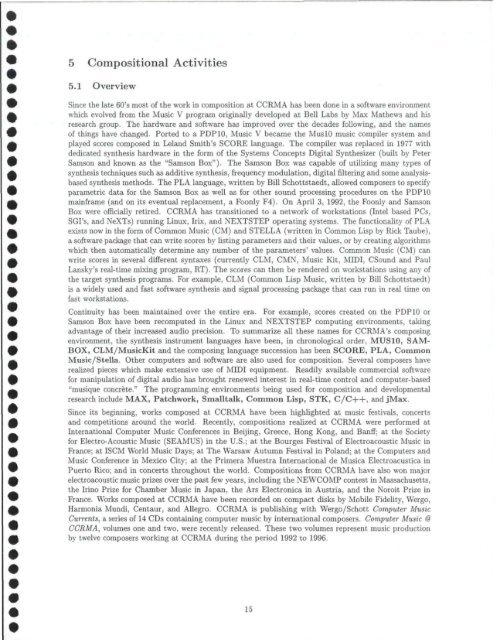CCRMA OVERVIEW - CCRMA - Stanford University
CCRMA OVERVIEW - CCRMA - Stanford University
CCRMA OVERVIEW - CCRMA - Stanford University
You also want an ePaper? Increase the reach of your titles
YUMPU automatically turns print PDFs into web optimized ePapers that Google loves.
5 Compositional Activities<br />
5.1 Overview<br />
Since the late 60's most of the work in composition at <strong>CCRMA</strong> has been done in a software environment<br />
which evolved from the Music V program originally developed at Bell Labs by Max Mathews and his<br />
research group. The hardware and software has improved over the decades following, and the names<br />
of things have changed. Ported to a PDP10, Music V became the MuslO music compiler system and<br />
played scores composed in Leland Smith's SCORE language. The compiler was replaced in 1977 with<br />
dedicated synthesis hardware in the form of the Systems Concepts Digital Synthesizer (built by Peter<br />
Samson and known as the "Samson Box"). The Samson Box was capable of utilizing many types of<br />
synthesis techniques such as additive synthesis, frequency modulation, digital filtering and some analysisbased<br />
synthesis methods. The PLA language, written by Bill Schottstaedt, allowed composers to specify<br />
parametric data for the Samson Box as well as for other sound processing procedures on the PDP10<br />
mainframe (and on its eventual replacement, a Foonly F4). On April 3, 1992, the Foonly and Samson<br />
Box were officially retired. <strong>CCRMA</strong> has transitioned to a network of workstations (Intel based PCs,<br />
SGI's, and NeXTs) running Linux, Irix, and NEXTSTEP operating systems. The functionality of PLA<br />
exists now in the form of Common Music (CM) and STELLA (written in Common Lisp by Rick Taube),<br />
a software package that can write scores by listing parameters and their values, or by creating algorithms<br />
which then automatically determine any number of the parameters' values. Common Music (CM) can<br />
write scores in several different syntaxes (currently CLM, CMN, Music Kit, MIDI, CSound and Paul<br />
Lansky's real-time mixing program, RT). The scores can then be rendered on workstations using any of<br />
the target synthesis programs. For example, CLM (Common Lisp Music, written by Bill Schottstaedt)<br />
is a widely used and fast software synthesis and signal processing package that can run in real time on<br />
fast workstations.<br />
Continuity has been maintained over the entire era. For example, scores created on the PDP10 or<br />
Samson Box have been recomputed in the Linux and NEXTSTEP computing environments, taking<br />
advantage of their increased audio precision. To summarize all these names for <strong>CCRMA</strong>'s composing<br />
environment, the synthesis instrument languages have been, in chronological order, MUS10, SAM-<br />
BOX, CLM/MusicKit and the composing language succession has been SCORE, PLA, Common<br />
Music/Stella. Other computers and software are also used for composition. Several composers have<br />
realized pieces which make extensive use of MIDI equipment. Readily available commercial software<br />
for manipulation of digital audio has brought renewed interest in real-time control and computer-based<br />
"musique concrete." The programming environments being used for composition and developmental<br />
research include MAX, Patchwork, Smalltalk, Common Lisp, STK, C/C++, and jMax.<br />
Since its beginning, works composed at <strong>CCRMA</strong> have been highlighted at music festivals, concerts<br />
and competitions around the world. Recently, compositions realized at <strong>CCRMA</strong> were performed at<br />
International Computer Music Conferences in Beijing, Greece, Hong Kong, and Banff; at the Society<br />
for Electro-Acoustic Music (SEAMUS) in the U.S.; at the Bourges Festival of Electroacoustic Music in<br />
France; at ISCM World Music Days; at The Warsaw Autumn Festival in Poland; at the Computers and<br />
Music Conference in Mexico City; at the Primera Muestra Internacional de Musica Electroacustica in<br />
Puerto Rico; and in concerts throughout the world. Compositions from <strong>CCRMA</strong> have also won major<br />
electroacoustic music prizes over the past few years, including the NEWCOMP contest in Massachusetts,<br />
the Irino Prize for Chamber Music in Japan, the Ars Electronica in Austria, and the Noroit Prize in<br />
France. Works composed at <strong>CCRMA</strong> have been recorded on compact disks by Mobile Fidelity, Wergo,<br />
Harmonia Mundi, Centaur, and Allegro. <strong>CCRMA</strong> is publishing with Wergo/Schott Computer Music<br />
Currents, a series of 14 CDs containing computer music by international composers. Computer Music @<br />
<strong>CCRMA</strong>, volumes one and two, were recently released. These two volumes represent music production<br />
by twelve composers working at <strong>CCRMA</strong> during the period 1992 to 1996.<br />
L5

















